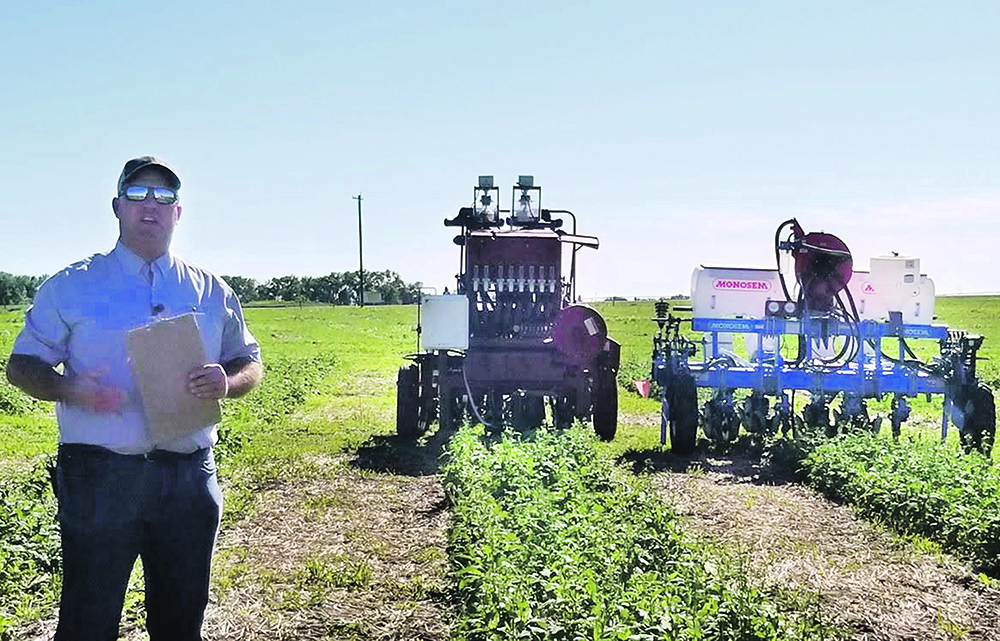Alta. research centre launches project exploring what methods and tools are needed to boost canola yields by 35 percent
A three-year research project will not be reinventing the wheel in its efforts to help southern Alberta farmers find ways to meet the rising demand for canola, says an expert.
“It’s a really great example of what I consider adaptive research,” said Ken Coles, executive director of Farming Smarter.
The project involves taking proven technologies that work elsewhere in Canada or North America “and tweaking them to our growing environment and our profit system,” he said.
Farmers must grow 26 million tonnes of canola per year by 2025 in Western Canada to meet the demand predicted by the Canola Council of Canada, up from 18.6 million tonnes in 2019. If the amount of acreage stays the same, it means the current average yield for canola must be boosted about 35 percent, said a project synopsis.
Read Also

Growing garlic by the thousands in Manitoba
Grower holds a planting party day every fall as a crowd gathers to help put 28,000 plants, and sometimes more, into theground
The initiative, which will cost about $300,000, is partly funded by a grant of $75,000 per year from the federal Natural Sciences and Engineering Research Council of Canada. Scientists will look at the effect of precision planting and strip tillage on canola crops, said a project statement.
“Since we have short, cold growing seasons, it’s important to properly prepare the seed bed so that seeds have a better chance to germinate,” Rezvan Karimi Dehkordi of Lethbridge College said in the statement.
As a research associate with the college’s Mueller Applied Research in Irrigation Science team, she is leading the project along with research scientist Gurbir Dhillon of Farming Smarter, a producer-led agricultural research association in southern Alberta.
Precision planting involves placing seeds at a precise depth and spacing, said the statement.
“Farming Smart has had great success in adopting precision planters to seed various crops, including pulses, wheat and hemp,” added Dhillon in the statement.
“In this project, we will evaluate different types of tillage operations and seeding methods to manage previous crop residues and determine if we can improve canola emergence and yield under both dryland and irrigated conditions.”
The project will include a comparison of air seeders to vacuum planters, said Coles.

“One of the challenges that we found with planters in general is they weren’t necessarily designed with our cropping systems in mind in Western Canada.”
Air seeders are more typically used by prairie farmers, but there is increasing interest in adopting vacuum planters for canola, he said. Although adaptations have been made to planters, they are not yet where they need to be in order to be fully integrated into the region’s production, he added.
Previous research involving vacuum planters found significant improvements for crops such as chickpeas, lentils, fababeans and durum on irrigated land, said Coles.
However, especially for irrigated canola, planters have resulted in better seed placement, seed-to-soil contact and a more even emergence, resulting in a “tremendous yield advantage,” he said. “Under the dry land, not as big a success, especially given the fact that we’ve had multiple years of drought, but still, a lot of potential is popping up with the use of planters.”
The project will also look at strip tillage “as an approach to prepare the seed bed to be able to put the fertilizer down ahead of time and deep down, and to use the planters in a way they were kind of designed to do — with adaptations to, again, Western Canada — so we’re going to go on narrower row spacing,” he said.
“We have to adapt strip tillage machines to be narrower and to be working in our types of soil and our environment.”
Strip tillage prepares and fertilizes fields by tilling narrow strips for planting, rather than tilling the entire area, said Coles. It leaves undisturbed areas containing crop residue between the strips, said the project statement.
“Studies show this can reduce soil erosion and soil compaction and improve soil quality.”
Although parts of southern Alberta are having success with wide rows, “in our neck of the woods, especially under irrigation and higher yield potential, we found that the typical wide row spacing wasn’t going to be efficient or effective for use in small grains (such as canola),” said Coles.
If the project is successful, he would like to expand it to other agricultural environments across Alberta and Canada. The initiative marks the first formal working agreement between Lethbridge College and Farming Smarter, he said.
They cemented a long-standing relationship in 2020 through a 15-year collaboration agreement “that committed the two partners to pursuing opportunities to support the entire agriculture industry in southern Alberta and throughout the province,” said the statement.


















